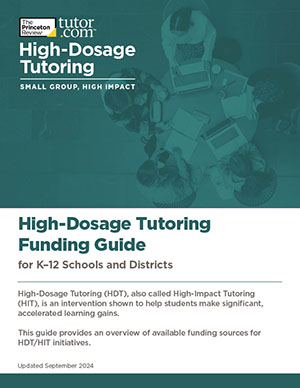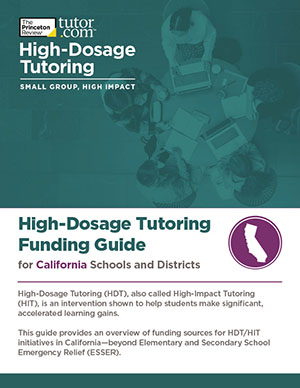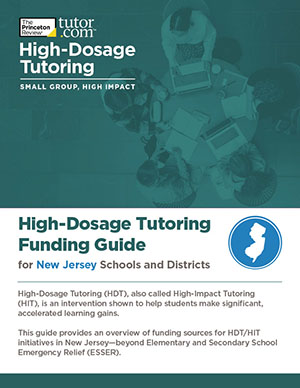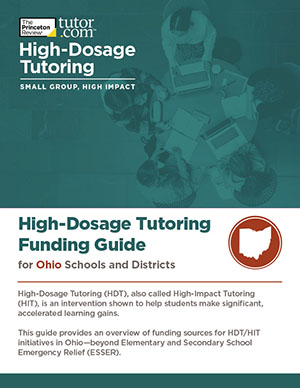
High-Dosage Tutoring
High-Frequency, High-Impact Tutoring
A research-based, intensive solution to help K–12 schools and districts accelerate learning for at-risk students


I have never seen my students so engaged with a virtual learning tool.
Based on their concentration level, I thought they were playing video games until I took a closer look at their screens to see that they were engaged in their tutoring session. They also reported having great rapport with their tutors, and students that are not shy to complain about anything fielded no complaints about participating in high-dosage tutoring.
—Teacher, Fresno Unified School District


Recognized Excellence in High-Dosage Tutoring
Our HDT program has earned the prestigious Tutoring Program Design Badge from Stanford University's National Student Support Accelerator (NSSA). Learn more.
What Sets Us Apart

Best-in-class instructional methodology
T.U.T.O.R. (Teach, Understand, Try It, Own It, Reflect), our proprietary gradual-release instructional model, empowers students to achieve understanding and make significant learning gains. We have a track record of effective tutoring, with 28+ million sessions delivered.

Assessment-based learning accelerator
We are student-centric and data-driven. Each student takes summative assessments along with post-session formative assessments (exit tickets), which allow tutors to identify learning needs and personalize instruction. Tutors provide real-time feedback in Lesson Notes, accessible as part of our robust on-demand reporting for classroom teachers and administrators in a dedicated dashboard.

Teacher-led program development
The experts who developed our High-Dosage Tutoring programs are all educators themselves, with an average of 10+ years of teaching experience each. They purpose-built our curricula for delivery in a tutoring format, based on principles for effective tutoring. We also partner with districts to group students for the best outcomes.

Standards-aligned curriculum
We’re not “content-agnostic.” Our high-quality curriculum is aligned to state standards, and our ELA program follows the Science of Reading pillars. Our learning progressions are customizable to best meet the needs of schools and students. Our content is visually stimulating and fun for students to engage with.

Highly trained tutors
Rigorously vetted, background-checked, fingerprinted educators who are verified subject-matter experts serve as our tutors. They are intensively trained and continuously supported by a team of Instructional Specialists, who help them deliver best-in-class instruction that generates positive student outcomes.

Education-forward classroom tools
Our award-winning online platform features tools to create an interactive and productive learning environment, including breakout rooms for differentiated instruction, text/chat/video capabilities, a collaborative whiteboard, and classroom resources that maximize student engagement.

Research-grounded program design
Based on extensive research from the Annenberg Institute and the University of Chicago Education Lab, our programs drive positive student outcomes with: 3x/week frequency, individual/small-group learning, tailored instruction, ongoing progress monitoring, and a consistent tutor to ensure continuity of learning and strong, caring tutor–student relationships.
High-Dosage Tutoring Funding Guides
Learn more about High-Dosage Tutoring funding programs with our guides. Find your state below, or download the all-purpose guide for all states.
Video Library
Learn about our instructional design, teaching methodology, and more.
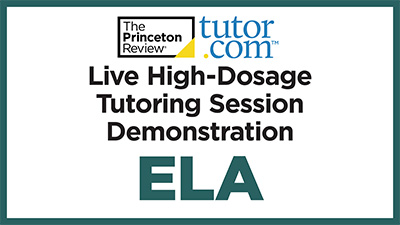
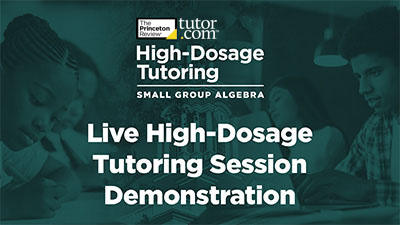
Multi-Tiered System of Supports
With an equitable MTSS, all students get the support services
they need to meet a wide range of needs.
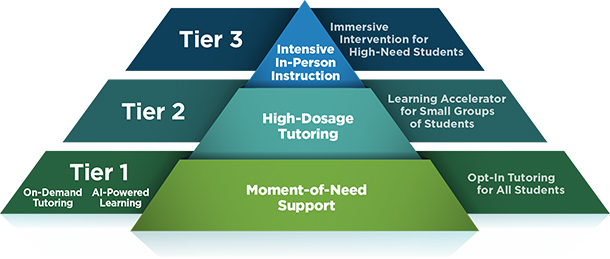
How It Works
High-impact tutoring enables teachers to refer students who need intensive subject support, and then receive Lesson Reports three times per week to chart learner achievements.
Available student data is evaluated

Group of up to 4 students with similar needs is formed

Group-specific scope and sequence are charted at launch and adapted throughout the tutorial

Students meet with the same tutor during school hours, 3 times per week

Tutor delivers tailored, interactive instruction and writes Lesson Reports after each session

Students complete periodic formative assessments to promote independent practice, support progress monitoring, and deliver reportable results

Teacher can monitor topics covered, attendance, and student progress through the Teacher Dashboard
FAQ
What is the research behind high-dosage tutoring?
Though the efficacy of high-impact tutoring has been documented for some time, the approach became central to many school districts’ response to learning loss amid the COVID-19 pandemic. The California School Boards Association concluded in 2021 that the model “drastically improves learning” in the context of COVID-related learning loss, while a University of Chicago study of more than 5,000 Chicago Public Schools ninth- and tenth-graders found that the intervention resulted in an additional 2.5 years’ worth of math instruction within a single academic year and substantially narrowed the socioeconomic access and achievement gaps that had widened during the pandemic.
A 2021 meta-analysis conducted by the Annenberg Institute of studies from across the United States showed that tutoring could “meaningfully increase learning for a wide variety of K–12 students.” Similarly, a 2017 study that evaluated the efficacy several comparably complex interventions—tutoring, progress monitoring, cooperative learning, computer-assisted instruction, and mentoring—found that tutoring had the greatest impact in measurable learning outcomes among socioeconomically disadvantaged populations.
Does high-dosage tutoring take place online or in person?
High-impact tutoring is delivered online via LEO, our comprehensive proprietary academic support delivery platform. Research suggests that online delivery is just as effective as in-person sessions, and online delivery is often easier for students to schedule and participate in.
In which subject areas do you offer high-dosage tutoring?
High-Dosage Tutoring is available in Algebra I, Middle School Math, Elementary Math, Elementary ELA, and Middle School ELA.
How long do sessions last?
Each session will be 30–45 minutes in duration. Students will engage in sessions three or more times per week.
How many students get tutored at the same time?
A maximum of four students participate in high-impact tutoring with a single instructor.
What is the difference between high-impact tutoring and on-demand tutoring?
The critical difference is that high-impact tutoring is necessarily high-frequency (three times per week), subject-intensive (in a single area), curriculum-based, and pre-scheduled. In addition, high-impact tutoring is delivered to small groups of three or four students at once. On-demand tutoring, by contrast, is delivered as needed in a variety of subject areas, on a one-to-one basis.
Read more about the difference between high-impact and on-demand tutoring.
